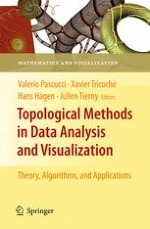2011 | OriginalPaper | Buchkapitel
Topological Flow Structures in a Mathematical Model for Rotation-Mediated Cell Aggregation
verfasst von : Alexander Wiebel, Raymond Chan, Christina Wolf, Andrea Robitzki, Angela Stevens, Gerik Scheuermann
Erschienen in: Topological Methods in Data Analysis and Visualization
Verlag: Springer Berlin Heidelberg
Aktivieren Sie unsere intelligente Suche, um passende Fachinhalte oder Patente zu finden.
Wählen Sie Textabschnitte aus um mit Künstlicher Intelligenz passenden Patente zu finden. powered by
Markieren Sie Textabschnitte, um KI-gestützt weitere passende Inhalte zu finden. powered by
In this paper we applyvector field topology methods to amathematical model for the fluid dynamics of reaggregation processes in tissue engineering. The experimental background are dispersed embryonic retinal cells, which reaggregate in a rotation culture on a gyratory shaker, according to defined rotation and culture conditions. Under optimal conditions, finally complex 3D spheres result. In order to optimize high throughput drug testing systems of biological cell and tissue models, a major aim is to understand the role which the fluid dynamics plays in this process. To allow for a mathematical analysis, an experimental model system was set up, using micro-beads instead of spheres within the culture dish. The qualitative behavior of this artificial model was monitored in time by using a camera. For this experimental setup amathematical model for the bead-fluid dynamics was derived, analyzed and simulated. The simulations showed that the beads form distinctive clusters in a layer close to the bottom of the petri dish. To analyze these patterns further, we perform a topological analysis of thevelocity field within this layer of the fluid. We find that traditional two-dimensional visualization techniques like path lines, streak lines and currenttime-dependent topology approaches are not able to answer the posed questions, for example they do not allow to find the location of clusters. We discuss the problems of these techniques and develop a new approach that measures thedensity of advected particles in the flow to find the moving point of particleaggregation. Using thedensity field the path of the movingaggregation point is extracted.
